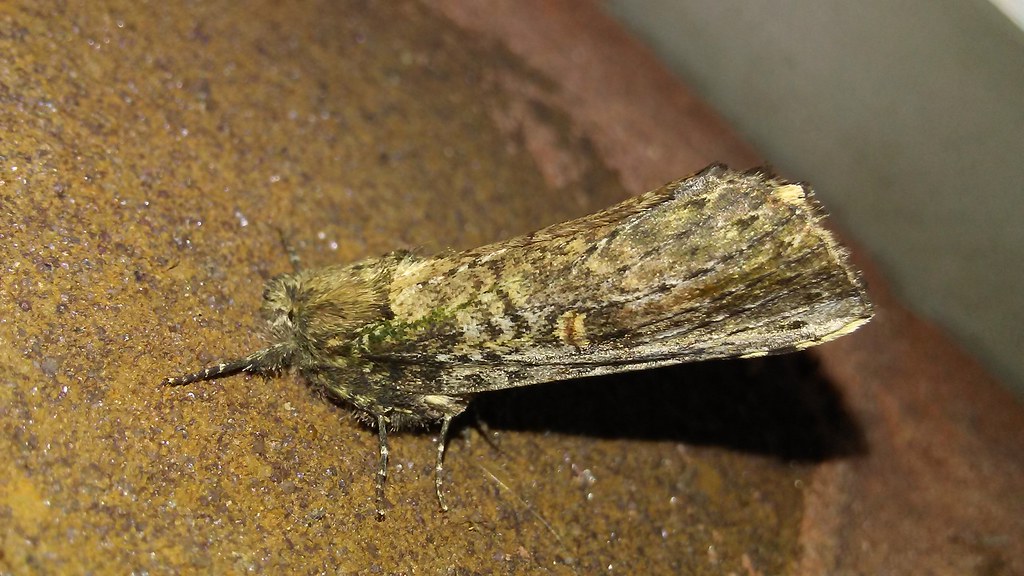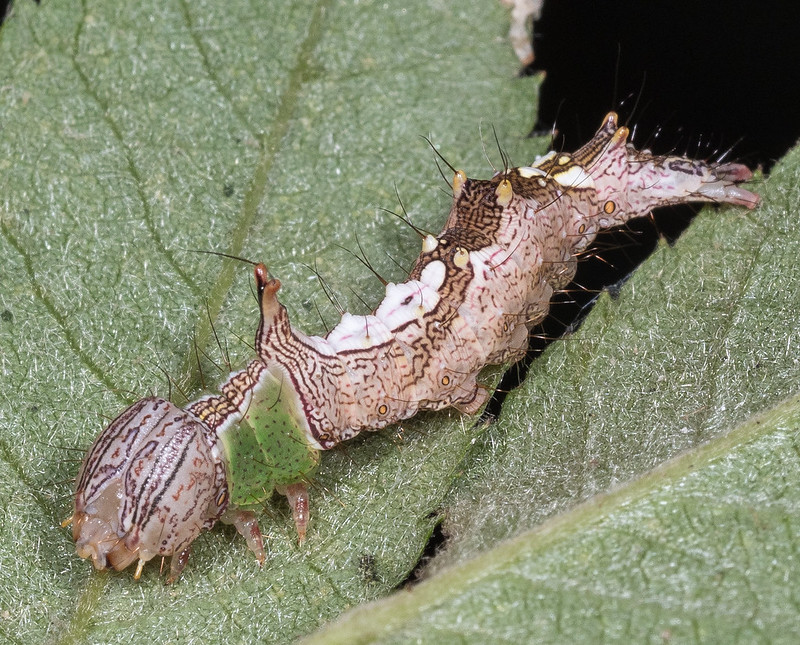Map Snapshot



















126 Records
Seasonality Snapshot
Use of media featured on Maryland Biodiversity Project is only permitted with express permission of the photographer.
A Morning Glory Prominent Moth in Frederick Co., Maryland (7/11/2016).
View Record Details
Media by
Mark Etheridge.
A Morning-glory Prominent Moth in Garrett Co., Maryland (8/16/2013).
View Record Details
Media by
Matt Tillett.
A Morning-glory Prominent Moth in Baltimore Co., Maryland (7/12/2020).
View Record Details
Media by
Dave Webb.
A Morning-glory Prominent Moth in Worcester Co., Maryland (5/28/2013).
View Record Details
Media by
Scott Housten.
A Morning-glory Prominent Moth in Harford Co., Maryland (8/23/2015). Verified by Roger Downer/BAMONA.
View Record Details
Media by
Dave Webb.
A Morning-glory Prominent Moth in Worcester Co., Maryland (5/29/2013).
View Record Details
Media by
Scott Housten.
A Morning-glory Prominent Moth in Frederick Co., Maryland (8/31/2015).
View Record Details
Media by
Mark Etheridge.
A Morning-glory Prominent Moth in Frederick Co., Maryland (6/29/2016).
View Record Details
Media by
Mark Etheridge.
A Morning-glory Prominent Moth in Anne Arundel Co., Maryland (6/12/2019).
View Record Details
Media by
Tyler Bell.
A Morning-glory Prominent Moth in Harford Co., Maryland (7/18/2019).
View Record Details
Media by
Dave Webb.
A male Morning-glory Prominent Moth in Harford Co., Maryland (8/18/2022).
View Record Details
Media by
Dave Webb.
Morning-glory Prominent Moth in Montgomery Co., Maryland (7/24/2011). (c) James Reilly, some rights reserved (CC BY-NC).
View Record Details
Media by
James Reilly via iNaturalist.
A Morning-glory Prominent Moth in Cecil Co., Maryland (8/11/2020). Verified by Roger Downer/BAMONA.
View Record Details
Media by
Dave Webb.
A Morning-glory Prominent Moth in Howard Co., Maryland (8/20/2020).
View Record Details
Media by
Kurt Schwarz.
A Morning-glory Prominent Moth in Worcester Co., Maryland (5/29/2013).
View Record Details
Media by
Scott Housten.
A Morning-glory Prominent Moth in Howard Co., Maryland (8/6/2014).
View Record Details
Media by
Nancy Magnusson.
A Morning-glory Prominent Moth in Prince George's Co., Maryland (8/3/2010).
View Record Details
Media by
Bob Patterson.
A Morning-glory Prominent Moth in Prince George's Co., Maryland (8/5/2010).
View Record Details
Media by
Bob Patterson.
A Morning-glory Prominent Moth in Calvert Co., Maryland (6/25/2006).
View Record Details
Media by
Arlene Ripley.
A Morning-glory Prominent Moth in Howard Co., Maryland (8/18/2003).
View Record Details
Media by
Larry Line.
A Morning-glory Prominent Moth larva in Baltimore Co., Maryland (7/12/2021).
View Record Details
Media by
Richard Crook.
Morning-glory Prominent Moth in Howard Co., Maryland (8/25/2024). (c) Jim Moore (Maryland), some rights reserved (CC BY-NC).
View Record Details
Media by
Jim Moore.
A Morning-glory Prominent Moth caterpillar in Calvert Co., Maryland (8/9/2016).
View Record Details
Media by
Ben Springer.
Morning-glory Prominent Moth in Howard Co., Maryland (8/25/2024). (c) Jim Moore (Maryland), some rights reserved (CC BY-NC).
View Record Details
Media by
Jim Moore.
Morning-glory Prominent Moth in Frederick Co., Maryland (9/28/2016).
View Record Details
Media by
Bob Cammarata.
A Morning-glory Prominent Moth caterpillar in Howard Co., Maryland (9/26/2013).
View Record Details
Media by
Bonnie Ott.
A Morning-glory Prominent Moth in Caroline Co., Maryland (8/14/2010).
View Record Details
Media by
Jim Brighton.
A Morning-glory Prominent Moth caterpillar in Dorchester Co., Maryland (8/17/2018). Verified by John and Jane Balaban/BugGuide.
View Record Details
Media by
Mark Etheridge.
A Morning-glory Prominent Moth larva in Howard Co., Maryland (7/24/2015).
View Record Details
Media by
Bonnie Ott.
A Morning-glory Prominent Moth caterpillar in Baltimore City, Maryland (9/14/2013). Determined by John and Jane Balaban/BugGuide.
View Record Details
Media by
Thomas Wilson.
A Morning-glory Prominent Moth caterpillar in Charles Co., Maryland (9/25/2016). Determined by Ross Hill/BugGuide.
View Record Details
Media by
Beth Johnson.
A Morning-glory Prominent Moth caterpillar in Charles Co., Maryland (9/8/2010).
View Record Details
Media by
Eric Gofreed.
A Morning-glory Prominent Moth caterpillar in Howard Co., Maryland (9/2/2013).
View Record Details
Media by
Richard Orr.
A Morning-glory Prominent Moth in Frederick Co., Maryland (8/28/2016).
View Record Details
Media by
Richard Orr.
A Morning-glory Prominent Moth caterpillar in Kent Co., Maryland (7/11/2014).
View Record Details
Media by
Nancy Martin.
A Morning-glory Prominent Moth caterpillar in Prince George's Co., Maryland (10/2/2013).
View Record Details
Media by
Yvonne Dobson.
A Morning-glory Prominent Moth caterpillar in Anne Arundel Co., Maryland (8/3/2018).
View Record Details
Media by
Bob Cammarata.
A Morning-glory Prominent Moth caterpillar in Frederick Co., Maryland (8/31/2019).
View Record Details
Media by
Mark Etheridge.
Morning-glory Prominent Moth in Montgomery Co., Maryland (8/14/2020). (c) peroed, some rights reserved (CC BY-NC).
View Record Details
Media by
peroed via iNaturalist.
Schizura ipomaeae caterpillar in Howard Co., Maryland (9/10/2022).
View Record Details
Media by
Jim Moore.
A Morning-glory Prominent Moth larva in Kent Co., Maryland (7/3/2014).
View Record Details
Media by
Nancy Martin.
A Morning-glory Prominent Moth caterpillar in Frederick Co., Maryland (7/3/2017).
View Record Details
Media by
Eric Stavale.
Source: Wikipedia
| Schizura ipomoeae | |
|---|---|

| |
| Scientific classification | |
| Domain: | Eukaryota |
| Kingdom: | Animalia |
| Phylum: | Arthropoda |
| Class: | Insecta |
| Order: | Lepidoptera |
| Superfamily: | Noctuoidea |
| Family: | Notodontidae |
| Genus: | Schizura |
| Species: | S. ipomoeae
|
| Binomial name | |
| Schizura ipomoeae Doubleday, 1841
| |
| Synonyms | |
| |
Schizura ipomoeae, the morning-glory prominent moth or false unicorn caterpillar, is a moth of the family Notodontidae. The species was first described by Edward Doubleday in 1841.[1][2] It is found in the United States and southern Canada.[3]
The wingspan is 36–47 mm. Adults are on wing from April to September in the south and from June to August in the north. There is one generation per year in the north.
The larvae feed on the leaves of various woody plants, including Fagus, Betula, Ulmus, Acer, Ipomoea, Quercus, Hamamelis, and Rosa species. Larvae can be found from May to October. The species overwinters in the pupal stage.
Taxonomy
[edit]There are a number of described forms.[4]
Gallery
[edit]-
Larva
-
Larva
-
Damage
References
[edit]- ^ Savela, Markku, ed. (July 26, 2019). "Schizura ipomaeae Doubleday, 1841". Lepidoptera and Some Other Life Forms. Retrieved November 10, 2020.
- ^ "930098.00 – 8005 – Schizura ipomaeae – Morning-glory Prominent – Doubleday, 1841". North American Moth Photographers Group. Mississippi State University. Retrieved November 10, 2020.
- ^ Balaban, John and Jane (September 3, 2017). "Species Schizura ipomaeae - Morning-glory Prominent - Hodges#8005". BugGuide. Retrieved November 10, 2020.
- ^ Robinson, E. & Anweiler, G. G. (September 2004). "Species Details Schizura ipomoeae". University of Alberta Museums. E.H. Strickland Entomological Museum. Retrieved November 10, 2020.











































